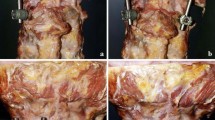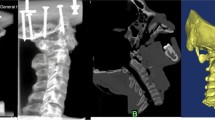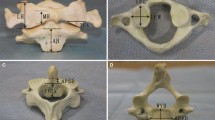Abstract
Purpose
To investigate the anatomical and biomechanical feasibility of the unilateral C1 double screw [pedicle screw (PS) + lateral mass screw (LMS)] and ipsilateral C2 PS combined with contralateral C2 laminar screw (LS)-rod fixation for atlantoaxial instability by comparison with traditional posterior fixation methods.
Methods
Fifteen sets of complete dry bony specimens of atlas were used for morphometric analysis. The working length, width and thickness of the C1 PSs and LMSs were manually measured. Ten fresh-frozen cervical spines (C0–C7) were used to complete the range of motion (ROM) testing in their intact condition, under destabilization and after stabilization by the following procedures: unilateral C1–C2 PS rod fixation (Group A), bilateral C1–C2 PS rod fixation (Group B), and unilateral C1 double screw and ipsilateral C2 PS combined with contralateral C2 LS rod fixation (Group C).
Results
The working thickness of the C1 PS was ≤ 3.5 mm in only one (1/15 = 6.7%) specimen. The other parameters were > 3.5 mm in all specimens. In the ROM test, all fixation groups showed significantly reduced flexibility in all directions compared with both the intact and destabilization groups. Further, Groups B and C showed better stability in all directions than Group A. However, no significant differences were observed between Groups B and C.
Conclusion
The C1 unilateral lateral mass could mostly contain two screws(PS + LMS) with diameters ≤ 3.5 mm. The novel technique of unilateral C1 double screw and ipsilateral C2 PS combined with contralateral C2 LS rod fixation provided better stability than unilateral PS rod fixation and similar as bilateral PS rod fixation. Therefore, it is a feasible salvage method that provides a new insight into atlantoaxial instability.
Graphical abstract
These slides can be retrieved under Electronic Supplementary Material.






Similar content being viewed by others
References
Goel A, Laheri V (1994) Plate and screw fixation for atlanto-axial subluxation. Acta Neurochir 129(1–2):47–53
Harms J, Melcher RP (2001) Posterior C1–C2 fusion with polyaxial screw and rod fixation. Spine (Phila Pa 1976) 23(22):2467–2471
Resnick DK, Benzel EC (2002) C1–C2 pedicle screw fixation with rigid cantilever beam construct: case report and technical note. Neurosurgery 50(2):426–428
Fensky F, Kueny RA, Sellenschloh K et al (2014) Biomechanical advantage of C1 pedicle screws over C1 lateral mass screws: a cadaveric study. Eur Spine J 23(4):724–731
Eck JC, Walker MP, Currier BL, Chen Q, Yaszemski MJ, An KN (2007) Biomechanical comparison of unicortical versus bicortical C1 lateral mass screw fixation. J Spin Disord Tech 20(7):505–508
Ma XY, Yin QS, Wu ZH et al (2009) C1 pedicle screws versus C1 lateral mass screws: comparisons of pullout strengths and biomechanical stabilities. Spine (Phila Pa 1976) 34(4):371–377
Richter M, Schmidt R, Claes L, Puhl W, Wilke HJ (2002) Posterior atlantoaxial fixation: biomechanical in vitro comparison of six different techniques. Spine (Phila Pa 1976) 27(16):1724–1732
Paik SC, Chun HJ, Bak KH, Ryu J, Choi KS (2015) Unilateral C1 Lateral Mass and C2 Pedicle Screw Fixation for Atlantoaxial Instability in Rheumatoid Arthritis Patients: Comparison with the Bilateral Method. J Korean Neurosurg Soc 57(6):460–464
Bhatia N, Rama A, Sievers B et al (2017) Biomechanical evaluation of unilateral versus bilateral C1 lateral mass-C2 intralaminar fixation. Global Spine J 7(3):239–245
Tan M, Wang H, Wang Y et al (2003) Morphometric evaluation of screw fixation in atlas via posterior arch and lateral mass. Spine (Phila Pa 1976) 28(9):888–895
Shen K, Deng Z, Yang J, Liu C, Zhang R (2017) Biomechanical study of novel unilateral C1 posterior arch screws and C2 laminar screws combined with an ipsilateral crossed C1–C2 pedicle screw-rod fixation for atlantoaxial instability. Arch Orthop Trauma Surg 137(10):1349–1355
Calisaneller T, Yilmaz C, Ozdemir O, Caner H (2008) Posterior atlantal lateral mass fixation technique with polyaxial screw and rod fixation system. Turkish Neurosurg 18(2):142–148
Chen JF, Wu CT, Lee SC, Lee ST (2005) Posterior atlantoaxial transpedicular screw and plate fixation. J Neurosurg Spine 2(3):386–392
Yoon KW, Ko JH, Cho CS, Lee SK, Kim YJ, Kim YJ (2013) Endovascular treatment of vertebral artery injury during cervical posterior fusion (C1 lateral mass screw). A case report. Interv Neuroradiol 19(3):370–376
Lall R, Patel NJ, Resnick DK (2010) A review of complications associated with craniocervical fusion surgery. Neurosurgery 67(5):1396–1403
Wright NM (2004) Posterior C2 fixation using bilateral, crossing C2 laminar screws: case series and technical note. J Spinal Disord Tech 17(2):158–162
Du S, Ni B, Lu X et al (2017) Application of unilateral C2 translaminar screw in the treatment for atlantoaxial instability as an alternative or salvage of pedicle screw fixation. World Neurosurg 97:86–92
Christensen DM, Eastlack RK, Lynch JJ, Yaszemski MJ, Currier BL (2007) C1 anatomy and dimensions relative to lateral mass screw placement. Spine (Phila Pa 1976) 32(8):844–848
Seal C, Zarro C, Gelb D, Ludwig S (2009) C1 lateral mass anatomy: Proper placement of lateral mass screws. J Spinal Disord Tech 22(7):516–523
Gupta T (2008) Cadaveric morphometric anatomy of C-1 vertebra in relation to lateral mass screw placement. Surg Radiol Anat 30(7):589–593
Simsek S, Yigitkanli K, Seçkin H et al (2009) Ideal screw entry point and projection angles for posterior lateral mass fixation of the atlas: an anatomical study. Eur Spine J 18(9):1321–1325
Ma XY, Yin QS, Wu ZH, Xia H, Liu JF, Zhong SZ (2007) Anatomic considerations for the pedicle screw placement in the first cervical vertebra. Spine (Phila Pa 1976) 30(13):1519–1523
Lee MJ, Cassinelli E, Riew KD (2006) The feasibility of inserting atlas lateral mass screws via the posterior arch. Spine 31(24):2798–2801
Zhang XL, Huang DG, Wang XD et al (2017) The feasibility of inserting a C1 pedicle screw in patients with ponticulus posticus: a retrospective analysis of eleven patients. Eur Spine J 26(4):1058–1063
Funding
The study was supported by the national nature science foundation of China (No. 81301573), natural science foundation of Chongqing (No. cstc2013jcyjA10090), the special foundation for social safeguard and scientific innovation of Chongqing (No. cstc2016shms-ztzx10001-6), Science and technology foundation of Yuzhong district in Chongqing (No. 20160131), Chongqing research and innovation project of graduate students(No.YB17112).
Author information
Authors and Affiliations
Corresponding author
Ethics declarations
Conflict of interest
All authors have declared that they have no conflicts of interest.
Electronic supplementary material
Below is the link to the electronic supplementary material.
Rights and permissions
About this article
Cite this article
Shi, L., Shen, K., Deng, R. et al. Novel unilateral C1 double screw and ipsilateral C2 pedicle screw placement combined with contralateral laminar screw–rod fixation for atlantoaxial instability. Eur Spine J 28, 362–369 (2019). https://doi.org/10.1007/s00586-018-5853-0
Received:
Accepted:
Published:
Issue Date:
DOI: https://doi.org/10.1007/s00586-018-5853-0




